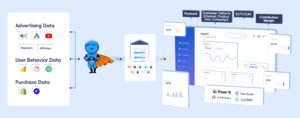The biggest battleground for customer acquisition today is the browser and the most powerful weapon to retain these customers is customer service. Every business is battling to get the attention of their next customer and sometimes even existing customers and nudge them to consider or reconsider their product or service. This battle on the digital front happens through a variety of channels including digital ads, PPC ads, emails, TV, and a whole host of other channels. Acquiring customers has always been and will continue to be one of the most expensive aspects of running a business.
In the context of digital business, whether that is a business selling merchandise, software, or a service, ensuring a smooth journey for the customer from the time they see the advertisement to the time they decide to make their first purchase is vital to ensuring marketing efforts are duly rewarded. Most businesses track their Customer Acquisition Costs (CAC) assiduously and marketers are held accountable for ensuring the CAC trendline is sloping downwards as time goes on.
It is understandable for an emerging company with a small customer base to focus its efforts primarily on acquisition to grow at the bottom of the pyramid. However, a business operating on the “Customer Acquisition Cost > Customer Lifetime Value” equation cannot be operational for too long without external financing. Although a strong focus on customer acquisition is vital, focusing merely on customer acquisition and not giving enough emphasis to driving customer retention and loyalty can hurt the prospects of the business in the long run.
Important of Customer Service
Mature businesses understand this dynamic and have underscored the importance of customer loyalty as evidenced by this quote from Jerry Gregoire, CIO at Dell, where he says, “The customer experience is the next competitive battleground.”
Studies by Bain & Company, Harvard Business School, have shown that even a 5 percent increase in customer retention can lead to a 25 – 95 percent increase in profitability.
Here are five reasons why companies should care about retaining existing customers and driving loyalty.
- Less marketing expenditure.
- Better average order value
- Identified areas of improvement
- Higher profits and lower costs
- Retention in comparison to acquisition is 6-7 times less costly
So, how can one improve customer retention? The answer lies in the ability of a company to provide its customers with the best customer experience they can deliver. However, measuring customer experience is easier said than done. Customers interact with companies in various channels, whether that is clicking an ad, browsing on the site, using the software or product, filing a customer support ticket, engaging with an onsite chat software, or even commenting on a post on social media.
Measuring their experience in all these channels and attributing that to revenue is a complex activity that requires a business to identify thoroughly all customer touchpoints with the company, establishing a mechanism to define and measure the efficiency at each of these touchpoints, and track these KPIs on an ongoing basis to ensure that customers receive the best experience possible.
Of all the areas that could potentially impact customer experience like price, site performance, delivery, customer service, loyalty programs, and others, the one with the highest amount of human interaction in customer service. Customer service has the potential to increase or decrease retention, and providing excellent customer service can influence customers to not only come back and repurchase, but can turn them into your most loyal advocates while poor customer experience might alienate a customer from the business for good.
For businesses that leverage customer support software like Freshdesk or Fresh chat, understanding the activity in these systems and tying that data with transaction data is key to understanding the impact of customer service on loyalty.
The market is full of businesses that talk about identifying customer pain points and installing efficient service centers as a clear opportunity, however, almost every customer perceives them poorly. The only organizations which can differentiate themselves in this intensely competitive environment are those that can proactively engage with their customers using advanced analytics. However, a lack of integrated data across channels has always been a bummer.
Creating a data warehouse with data from customer support systems and transactional systems will allow businesses to track customer retention KPIs in conjunction with activity in the customer service software.
Every business today can, with relative ease, own a data warehouse and get to a state where they can automate the tracking of KPIs, build advanced analytical models, and personalize customer support with relatively low effort. Below are some KPIs that a business should track on a day-to-day basis to ensure they are on top of their customer service game. Most customer service desk software may be providing some of the KPIs out of the box.
Service Desk level KPIs:
- Customer Satisfaction
- First Call Resolution (FCR)
- First Level Resolution Rate
- Customer waiting time
- First Response Time
- Customer handover rates
- Average Handle time
- Agents’ Product/service knowledge
- Agents’ problem-solving skills
- Cross-selling opportunities
- Customer Retention Rate
- Cost per Contact
- Agent Utilization
- Agent Satisfaction
- Net Promoter Score (NPS)
In addition to these KPIs, there can be a few other compound KPIs as well, derived by combining data from the service desk and the transactional database. For instance,
- No. of orders placed by customers posts service desk interaction. Orders post Interaction, this compound KPI, can be used to assess the quality of previous interactions and effectively improve the agent’s quality support delivery.
- Change in the loyalty of the customers in conjunction with the service desk level KPIs like FCR, First Level Resolution Rate, Customer Waiting Time and Agents’ problem-solving skills, etc. Delta Loyalty, the compound KPI in the discussion, is the change in the loyalty bucket of the customer over a number of service desk interactions and time.
- Based on the last order’s delivery status the agent can be notified to proactively initiate the resolution of the customer’s latest order. The KPI, Time for Delivery, can be calculated by checking if the current time for delivery has exceeded the number of days for delivery, intimated to the user at the time of order.
- Identifying customers’ favorite categories of products and cross-selling accordingly during customers’ appreciation service desk interactions. Service Desk Cross Sales can be a good indicator of all-around performance with loyal customers.
- Assessment of customer sentiment through the analysis of chat data and introducing retainer discounts. User sentiment can be predicted dynamically while the interaction by running an advanced NLP model. User’s Sentiment, a categorical KPI, which can predict the mood of users from the predefined moods [Joyful, Frustrated, Trust, etc.], can potentially help agents better assess the user and provide quality support.
At Saras Analytics, we make it easy for businesses to take control of their data through our product, Daton. Once the data is assembled in the data warehouse, analysts can then figure out the KPIs relevant for their business and then have these KPIs tracked on a frequent basis, automatically.













